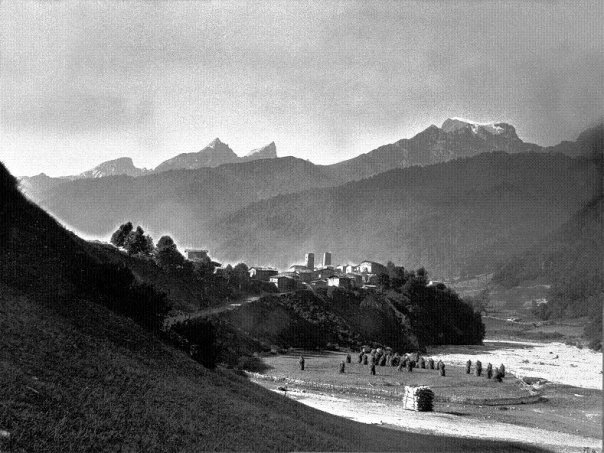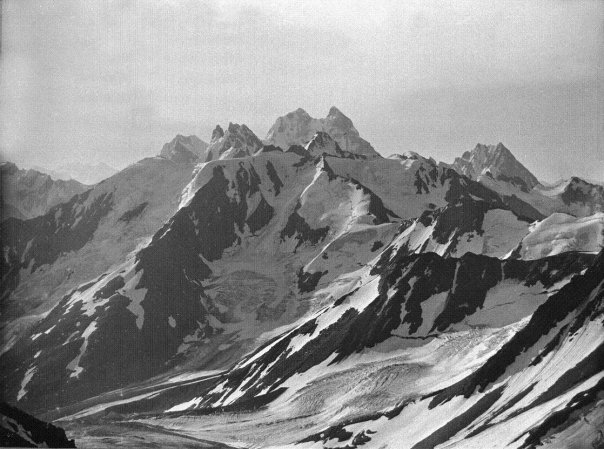

 Svaneti by Vittorio Sella in 1886-1890 (Set)
Svaneti by Vittorio Sella in 1886-1890 (Set)Vittorio Sella, a famous Italian mountaineer and photographer of the 19th century, spent considerable time exploring the wonders of Svaneti. Photographs taken during his travels there reveal the people who have also been influenced by their natural environment. They are tall like their mountains and their eyes are as blue as the Svanetian sky. Vittorio Sella travelled to Svaneti and Racha three times and mounted 30 peaks. He compiled a valuable material on Georgia. His photographs were exhibited in London in 1890 and received the highest award by the Royal Geographic Society.
In 1889-1890 the famous mountain-climber and pioneer of photography, Count Vittorio Sella made a number of climbs in Svaneti. Earlier he participated in the expeditions in the Alps, Africa and Asia, Alaska. He created an impressive series,which was later exhibited by the British Geographical Society. His studies, pictures and diaries were collected by his ancestor Lodovico Sella.
The interest toward Sella's figure revived, when the famous public figure end documentary film director Rezo Tabukashvili found and managed to bring to Tbilisi the collection of pictures taken by Sella in Svaneti and Racha.
One of the Caucasian peaks still bear the name of Vittorio Sella. These pictures represent the best samples of the photography of late XIX century. According to the famous American photographer Ansel Adams, the purity of Sella's interpretation inspires religious reverence. V. Sella photos are kept in the State CinemaPhotoPhono Archive.
Svanetia Land in Caucasus.
Italian photographer and alpinist Vittorio Sella in his book gave the description of Mt. Ushba seen from the upper course of the Ingur river, Svanetia: "Behind this village a much more ancient sovereign dominated the valley from on high: Mt. Ushba, the mountain of rain. At dusk this soaring peak is sublime in the elegance of its indomitable forms, if at first glance it is surprising, upon closer observation its fantastic lines simply fascinate one. The white pyramid of Mt. Tetnuld in the distance and the long snowy crest moving towards Mt. Shkhara are the background of a stupendously grandiose picture. "
Italian photographer and alpinist Vittorio Sella in his book gave the description of Mt. Ushba seen from the upper course of the Ingur river, Svanetia: "Behind this village a much more ancient sovereign dominated the valley from on high: Mt. Ushba, the mountain of rain. At dusk this soaring peak is sublime in the elegance of its indomitable forms, if at first glance it is surprising, upon closer observation its fantastic lines simply fascinate one. The white pyramid of Mt. Tetnuld in the distance and the long snowy crest moving towards Mt. Shkhara are the background of a stupendously grandiose picture. "
Blocked off to the north by the Greater Caucasus and to the south and east by the Sva-netskiy range, the peaks of which rise to 4,000 meters, the region has been virtually isolated since ancient times. In 253 B.C. the Georgian tsar Saurmag called the capital of Svanetia, Mestia, "the abode of silence and calm, " and sent his rebellious subjects there in exile. The region was never dominated hy feudatory princes; but a high price was paid for this independence. The inhabitants of the valley had to fight to the last man in cruel wars, barricaded in their typical fortress-like houses - singular towers made of square blocks of stone without windows. Many of these constructions still remain, especially in Mestiya; most of them were built in the period bridging the 12th and 13th centuries, during the golden age of Svanetia. According to legend, families found refuse from vendettas in these towers, remaining shut up there with arms and provisions for years on end. To this day Svanetian society has a tribal structure, the main cell of which, the clan, consists of 20-30 families (200-.?00 persons) that jealously preserve their ancient traditions. Mountaineering is also a part of Svanetian tradition, in 1903 a courageous hunter, Muratbi Kibolani, together with two Englishmen, was the first to climb Mt. Ushha from this side. The locals did not believe him, since they felt it was impossible to gain the top of the mountain, so Kibolani climbed the peak by himself and lit a fire to give proof of his feat. But the most famous alpinist in Svanetia was Michael Kherghiani, who took part in the first ascents of all the most difficult peaks in the Caucasus system. Together with V. Onischenko, he climbed some of the most arduous routes in the Alps, such as the Walker spur in the Grandes ]orasses and the Petit Dru. He died in the Dolomites in 1969 in Su Alto group.
AmazonShop: Books, Maps, Videos, Music & Gifts About The Caucasus











No comments:
Post a Comment